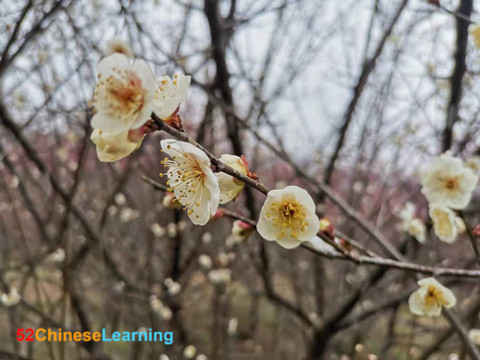链接复制成功!现在分享给好友吧。
Winter is the bane of living things. It turns the lively world into a cold, silent one. The once colorful world is now a place of white and gray. But you know what? Snow and plum blossoms are connected in traditional Chinese culture.
Winter halts everything. Everything. Rivers stop flowing. It succumbs to the merciless cold that freezes its every being. Plants stop growing. The cold cuts down its roots, making it impossible for the plant to gather nourishment. The land stops giving life. Instead, it becomes a humongous chunk of solidified horizontal wall, fighting the cold, only to no avail. Trees stop giving life. Its branches, once a haven for leaves, are now a sitting pot for ice and snow. Winter halts everything, except for one: Plum Blossoms.

1. Why This Topic
Plum blossom is the traditional flower of China. It blooms during the harsh winters and continues to radiate its beauty until spring. Since ancient times, plum blossoms have drawn people. Not only because of its beauty but also because of its nature.
See, while winter stops everything, it can’t stop plum blossoms from blooming. It is the perfect metaphor for hope, the epitome of resilience and strength. It shows that despite all odds, it will continue to blossom. No amount of cold can stop it from showing its elegance and beauty to the world.
Consequently, poets from archaic times composed poems to commemorate this tree. They understand the significance of its nature. They see how impactful it will be if we apply its disposition in our lives.
2. Poem for Plum Blossoms and Snow
That’s what we will examine today. A poem for the Plum Blossoms. To do that, let’s ride the memory lane.
The poem Snow and Plum Blossom 《雪梅》(XuěMéi) is a timeless classic. Its author, by Lu Meipo 卢梅坡 (Lú Méipō), is a prominent poet and writer in the Song Dynasty. In this poem, he delved into the monochromatic world of winter and how plum blossoms put vibrance and color during the soulless season.
The poem is as follows:
Xuě Méi
《雪梅》
Snow and Plum Blossom
Yǒu méi wú xuě bù jīng shén, yóu xuě wú méi sú le rén.
“有梅无雪不精神,有雪无梅俗了人。
Only plum blossoms have no snowflakes, and there seems to be no spiritual meaning. If it snows, but there is no poetry and prose, it will be very tacky.
Rì mù shī chéng tiān yòu xuě , yǔ méi bìng zuò shí fēn xiāng.
日暮诗成天又雪,与梅并作十分香。”
When the sun sets, the poem is written, and it just snows again.
Look at the plum blossoms and snowflakes competing to bloom, which are as colorful and vibrant as spring.
He also looked into the relationship between snow and plum blossoms. He noted how they seem to compete with each other.
He once iterated:
Méi xū xùn xuě sān fēn bái , xuě què shū méi yí duàn xiāng.
“梅须逊雪三分白,雪却输梅一段香。”
Plum blossoms have three points of white snow, but the snow loses one point of plum blossom fragrance.
3. Knowledge points
Now that we know the poem and what it generally means, let us now delve into the knowledge point of this topic.
①梅花 (méi huā): the second tone and the first tone, = plum blossom
②雪 (xuě): the third tone, = snow
Examples
Méi huā hé xuě shì tiān zuò zhī hé.
梅花 和 雪 是 天作之合。
Plum blossoms and snow are a perfect match.
Question
According to the passage, the poem Snow and Plum Blossom illustrates the relationship between which three things?
Your first 1-on-1 Chinese lesson offer